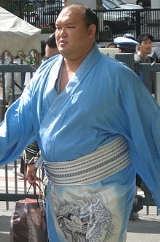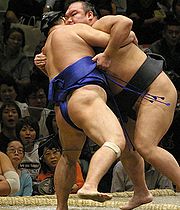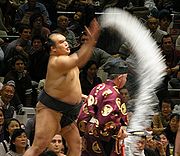
Kitazakura Hidetoshi
Encyclopedia
(born December 15, 1971 as is a former sumo
wrestler from Asakita ward
, Hiroshima City
, Japan
. His highest rank was maegashira 9. He is the elder brother of Toyozakura, also a top division wrestler. He was a popular figure with sumo fans. He is now a coach and elder
of the Japan Sumo Association
under the name Onogawa Oyakata.
. His brother Toyozakura became a sumo wrestler two years later. Unusually for brothers in sumo, they joined different stables, Toyozakura being recruited by Tatsutagawa stable. This was the wish of their father, a former sumo wrestler himself who reached the fourth highest sandanme division. Kitazakura and Toyozakura never met in competition, as brothers are not matched against each other.
 Initially wrestling using his real name, Kitazakura first adopted his current shikona
Initially wrestling using his real name, Kitazakura first adopted his current shikona
in November 1987. It took a long time to get to the salaried sekitori
ranks and he spent seven years from 1991 to 1998 in the third highest makushita division. He got as high as makushita 5 in September 1995 and a good performance might have got him promotion to the second jūryō division but he fell short with a 2-5 record. Reverting back to his own surname failed to change his fortunes and he fell right to the bottom of the makushita division. However after changing back to the name Kitazakura he took the makushita championship with a perfect 7-0 record in September 1997 and three more winning records finally earned him promotion to jūryō in July 1998, after a total of eleven years in the lower divisions.
Kitazakura did not reach the top makuuchi
division until July 2001 when he was in his thirtieth year, after winning the jūryō championship in May 2001. The 86 tournaments it took him to get there was the fourth slowest ever at the time (now the sixth slowest). He never managed to become a makuuchi regular, spending 48 of his 60 sekitori tournaments in jūryō, but he was very popular with the tournament crowds, due to his adoption of Mitoizumi
's trademark salt throwing routine in the pre-bout rituals. He was also renowned for his sheer eagerness to fight, forever imploring his opponent to start battle before the allotted time was up, demonstrating complete commitment to the principles of classic sumo.
 After a 5-10 result at jūryō 11 in January 2009 he was demoted to the unsalaried makushita division for the first time since 2003. Kitazakura did not retire as some expected and compiled a 4-3 record at Ms2w in March 2009, including one win against a jūryō sekitori (J13e Wakatenro). This however was not quite enough to send him back to sekitori status for the Natsu Basho, the three available places going to Sagatsukasa, Jumonji
After a 5-10 result at jūryō 11 in January 2009 he was demoted to the unsalaried makushita division for the first time since 2003. Kitazakura did not retire as some expected and compiled a 4-3 record at Ms2w in March 2009, including one win against a jūryō sekitori (J13e Wakatenro). This however was not quite enough to send him back to sekitori status for the Natsu Basho, the three available places going to Sagatsukasa, Jumonji
and Tamaasuka. He produced another 4-3 score in May and this time he was promoted back to jūryō. He is the second oldest wrestler in the modern era after Oshio
to earn promotion back to the jūryō division. However, he could score only 3-12 in the July 2009 tournament and returned to makushita.
while grappling being migi-yotsu, or left hand outside, right hand inside his opponent's arms. His most common winning kimarite
by far was a straightforward yori-kiri or force out, which determined the outcome of over half his victories at sekitori level.
Sumo
is a competitive full-contact sport where a wrestler attempts to force another wrestler out of a circular ring or to touch the ground with anything other than the soles of the feet. The sport originated in Japan, the only country where it is practiced professionally...
wrestler from Asakita ward
Asakita-ku, Hiroshima
is one of the eight wards of the city of Hiroshima, located in the North of Asa-gun and the South of Takata-gun: now-defunct districts .Asa-gun was consisted of Kabe-cho, Kōyō-cho, Asa-cho. Takata-gun was including Shiraki-cho...
, Hiroshima City
Hiroshima
is the capital of Hiroshima Prefecture, and the largest city in the Chūgoku region of western Honshu, the largest island of Japan. It became best known as the first city in history to be destroyed by a nuclear weapon when the United States Army Air Forces dropped an atomic bomb on it at 8:15 A.M...
, Japan
Japan
Japan is an island nation in East Asia. Located in the Pacific Ocean, it lies to the east of the Sea of Japan, China, North Korea, South Korea and Russia, stretching from the Sea of Okhotsk in the north to the East China Sea and Taiwan in the south...
. His highest rank was maegashira 9. He is the elder brother of Toyozakura, also a top division wrestler. He was a popular figure with sumo fans. He is now a coach and elder
Toshiyori
A toshiyori is a sumo elder of the Japan Sumo Association. Also known as oyakata, former wrestlers who reached a sufficiently high rank are the only people eligible...
of the Japan Sumo Association
Japan Sumo Association
The is the body that operates and controls professional sumo wrestling in Japan under the jurisdiction of the Japanese Ministry of Education, Culture, Sports, Science and Technology. Rikishi , gyōji , tokoyama , and yobidashi , are all on the Association's payroll, but the organisation is run...
under the name Onogawa Oyakata.
Career
Kitazakura made his professional debut in March 1987, joining Kitanoumi stableKitanoumi stable
is a stable of sumo wrestlers, part of the Dewanoumi ichimon or group of stables. It was set up in 1985 by former yokozuna Kitanoumi, who branched off from Mihogaseki stable. It absorbed Hatachiyama stable in 2006, following the death of its head coach, former ozeki Hokuten'yū...
. His brother Toyozakura became a sumo wrestler two years later. Unusually for brothers in sumo, they joined different stables, Toyozakura being recruited by Tatsutagawa stable. This was the wish of their father, a former sumo wrestler himself who reached the fourth highest sandanme division. Kitazakura and Toyozakura never met in competition, as brothers are not matched against each other.

Shikona
A shikona is a sumo wrestler's ring name.As with standard Japanese names, a shikona consists of a 'surname' and a 'given' name, and the full name is written surname first. However, the given name is rarely used outside formal or ceremonial occasions. Thus, the former yokozuna Asashōryū Akinori is...
in November 1987. It took a long time to get to the salaried sekitori
Sekitori
A sekitori is a sumo wrestler who is ranked in one of the top two professional divisions: makuuchi and juryo.Currently there are 70 rikishi in these divisions...
ranks and he spent seven years from 1991 to 1998 in the third highest makushita division. He got as high as makushita 5 in September 1995 and a good performance might have got him promotion to the second jūryō division but he fell short with a 2-5 record. Reverting back to his own surname failed to change his fortunes and he fell right to the bottom of the makushita division. However after changing back to the name Kitazakura he took the makushita championship with a perfect 7-0 record in September 1997 and three more winning records finally earned him promotion to jūryō in July 1998, after a total of eleven years in the lower divisions.
Kitazakura did not reach the top makuuchi
Makuuchi
or is the top division of professional sumo. Its size is fixed at 42 wrestlers , ordered into five ranks according to their ability as defined by their performance in previous tournaments....
division until July 2001 when he was in his thirtieth year, after winning the jūryō championship in May 2001. The 86 tournaments it took him to get there was the fourth slowest ever at the time (now the sixth slowest). He never managed to become a makuuchi regular, spending 48 of his 60 sekitori tournaments in jūryō, but he was very popular with the tournament crowds, due to his adoption of Mitoizumi
Mitoizumi Masayuki
Mitoizumi Masayuki is a former sumo wrestler from Mito, Ibaraki, Japan. His professional career spanned 22 years, from 1978 until 2000. The highest rank he reached was sekiwake. He won over 800 career bouts and took the yusho or championship in the top makuuchi division in 1992...
's trademark salt throwing routine in the pre-bout rituals. He was also renowned for his sheer eagerness to fight, forever imploring his opponent to start battle before the allotted time was up, demonstrating complete commitment to the principles of classic sumo.

Jumonji Masayasu
Jūmonji Tomokazu is a former sumo wrestler from Aomori, Japan. Joining the professional ranks in 1992, he reached the top division in 2000 and was ranked there for 34 tournaments until 2007. His highest rank was maegashira 6...
and Tamaasuka. He produced another 4-3 score in May and this time he was promoted back to jūryō. He is the second oldest wrestler in the modern era after Oshio
Oshio Kenji
Ōshio Kenji is a former sumo wrestler from Kitakyushu, Japan. His highest rank was komusubi. His career lasted twenty six years, from 1962 until 1988, and he holds the record for the most bouts contested in professional sumo.-Career:He was born in Yahata Higashi ward...
to earn promotion back to the jūryō division. However, he could score only 3-12 in the July 2009 tournament and returned to makushita.
Retirement from sumo
Kitazakura announced his retirement from active competition in March 2010, bringing an end to a 23 year career. His announcement came on the same day that Sendagawa Oyakata (the former ozeki Maenoyama) reached the mandatory retirement age of 65. This allowed Onogawa Oyakata (the former maegashira Yotsukasa) to switch to the Sendagawa kabu, leaving the Onogawa name free for Kitazakura. He will remain at his old stable as a coach.Fighting style
Kitazakura was a yotsu-sumo wrestler, his favourite grip on his opponent's mawashiMawashi
In sumo, a mawashi is the belt that the rikishi wears during training or in competition. Upper ranked professional wrestlers wear a keshō-mawashi as part of the ring entry ceremony or dohyo-iri.-Mawashi:...
while grappling being migi-yotsu, or left hand outside, right hand inside his opponent's arms. His most common winning kimarite
Kimarite
Kimarite are winning techniques in a sumo bout. For each bout in a Grand Sumo tournament , a sumo referee, or gyoji, will decide and announce the type of kimarite used by the winner...
by far was a straightforward yori-kiri or force out, which determined the outcome of over half his victories at sekitori level.
Top division record
See also
- Glossary of sumo termsGlossary of sumo termsThe following words are terms used in sumo wrestling in Japan. azukari : Hold. A kind of draw. After a mono-ii, the gyōji or the shimpan "holds" the result if it was too close to call...
- List of sumo tournament second division winners
- List of past sumo wrestlers

